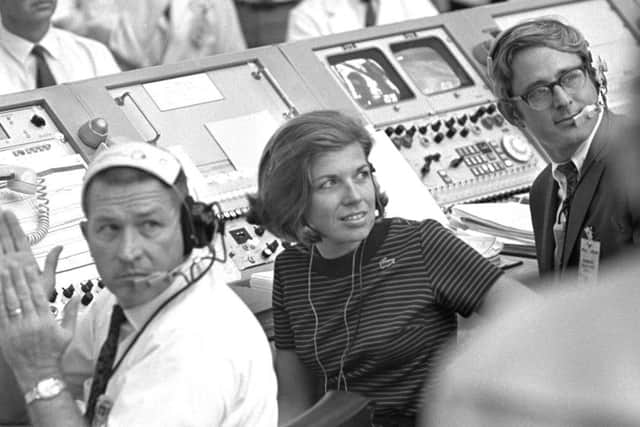Apollo 11 moon landing anniversary is a time to remember unsung heroes – Martyn McLaughlin
In the roll call of characters who wrote Apollo 11’s nationhood-transcending history, the top billing is understandably reserved for astronauts Neil Armstrong and Buzz Aldrin. It is they, after all, who made history as ambassadors of humankind, setting foot onto a far-flung celestial body.
Michael Collins, Apollo 11’s command module pilot, who watched on, fearful that catastrophe would intervene to ensure he would make the return to Earth alone, played an integral part in the mission.
Advertisement
Hide AdAdvertisement
Hide AdSo too did the many pioneers whose names occupy a mere footnote of history, despite the fact that without their expertise and composure, the disaster Collins feared – or much worse – would have almost inevitably come to pass.


The semicentennial celebrations of the Moon landing is an occasion to remember those who occupy the foothills of the credits. One of the statistics surrounding Project Apollo, which seems to me both remarkable and entirely rational, is that around 400,000 people were involved in rendering the impossible possible.
This army of engineers, scientists, programmers, mathematicians, and technicians defied technological limitations and bureaucratic wrangling to produce approximately five-and-a-half million parts which, working in unison, spirited Apollo’s crew to the Moon and back.
In any other corporate environment, the prospect of workers on the ground feeling disconnected from the mission’s overall goal would barely warrant concern. But Project Apollo’s programme manager, George Müller, knew fine well the risks of letting such apathy go unchecked. He ensured the astronauts toured factories across America tasked with manufacturing the spacecraft components. This was no mere public relations exercise. It reminded workers that a single oversight on their part could kill the men standing before them, and it forged a sense of collective responsibility.
Nowhere was this esprit de corps more evident than Building 30 of Nasa’s Johnson Space Centre in Houston, Texas, home to the Apollo mission operations control centre (MOCR), where the spacecraft’s navigation, propulsion, life support, and communications systems were monitored with unflinching scrutiny.
At any given time, between 20 and 30 men – and one trailblazing woman, JoAnn Morgan, the instrumentation controller – held in their hands the lives of three men a quarter of a million miles away.
Their number included Stephen Bales, the son of a janitor and a beautician, who less than five years previously had moved from the farming community of Fremont, Iowa, to join Nasa as an intern, responsible for guided tours.
In an interview with 13 Minutes to the Moon, a superb BBC World Service podcast detailing the graft, ingenuity, and composure which underpinned the final descent to the lunar surface, Bales recently reflected on the mission that would define his career. Without him, it would have probably ended in failure.
Advertisement
Hide AdAdvertisement
Hide AdAs the Eagle craft neared the Moon, an alarm code known as 1202 flashed on its on-board computer display. It was the only moment in the entire mission when a degree of urgency, if not fear, could be heard in Armstrong’s voice.
Bales, by then one of Apollo 11’s guidance officers, saw the alarm four seconds later. Initially unsure of its significance, he remembered the last simulation he and the flight controllers had carried out before the landing proper.
Back then a similar code, known as 1210, had appeared, prompting Bales to call an abort. In the subsequent debriefing, he immersed himself in the myriad alarms that could be triggered, working with Jack Garman, a computer specialist, to understand their meaning.
In doing so, they realised a 1202 referred to a software reboot which cancelled all the processes that the computer was running; crucially, it happened so fast, no vital guidance or navigation data would be lost.
So when the code appeared for real, Bales knew the mission could continue. It was a decision made in the space of 16 seconds – “an eternity,” said Bales – but it saved Apollo 11. There are countless other stories like his. Take that of John Aaron from Oklahoma, the son of a cattle rancher and a minister, recruited by Nasa at 22 without an interview.
He felt as if he had walked into a foreign country where people spoke another language, on account of the dizzying number of acronyms being hurled around. After just six weeks, he contemplated jacking it all in. Fortunately for him, and the Apollo programme, he knuckled down.
Only a few months later, his split-second decision making was credited with saving Apollo 12 after its rocket was struck by lightning.
It is difficult to conceive of the pressure these men worked under, as they analysed the spaceflight while listening to three, if not four conversations simultaneously on communication channels known as ‘loops’.
Advertisement
Hide AdAdvertisement
Hide AdThe average age of those inside MOCR was just 26, and as Gerry Griffin, the flight director during Apollo 11’s fraught re-entry into the Earth’s atmosphere, has pointed out, their youth counted in their favour. “It was the lack of fear,” he explained. “It wasn’t the lack of knowing it was risky.”
It also means that, half a century on, many of them are still with us, able to reflect on an epoch-defining moment and receive our thanks for the part they played in it.
